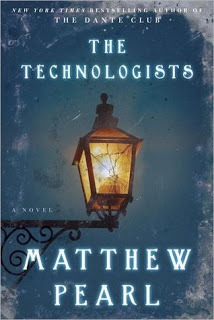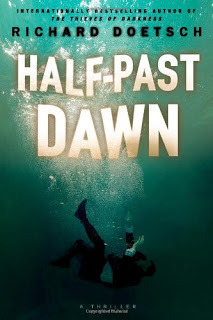Michael A. Draper's Blog, page 50
November 25, 2011
"There is no great future for people whose faith has burned out." Rufus M. Jones

In Oslo, Norway, Henning Juul is a crime reporter, returning to work after a fire killed his six-year-old son and left him scarred. It also ended his marriage.
Henning is in the image of financial journalist Mikael Blomkvist from Steig Larrsen's "The Millenium Series, both men are quiet, determined and total professionals..
On his first day back, a young woman's body is found at a local park. The woman, Henriette Hagerup had the marks of a stun gun and was stoned to death.
Authorities consider this could have been a ritual killing but Juul disagrees.
He possesses that rare investigative journalist talent for seeing when things just don't fit.
Through the story, Juul shows his compassion when interviewing friends and relatives of the deceased. With his personal history of the loss of his son and his physical and mental scars, the reader has to feel for the man, and yet, he doesn't ask for sympathy.
We follow the police investigation led by Det. Inspector Brogulund and his attractive, intelligent assistant, Sgt. Ella Sandland who is dedicated to finding the killer and has no interest in her bosses insuinations.
Juul is a true investigator and finding the reason why someone would kill Henriette consumes him. The title of the novel has many meanings, not only was Juul's own flat burned but he shows the scars of the fire and internally, he has the fire in his heart so much so that the reader catches his passion.
The setting is well described as is Juul, who the reader can relate to and wish that they could witness his power of deduction and bring the guilty to justice. The author provides some twists and surprises that keep the reader guessing right to the excellent conclusion.
November 22, 2011
"Be nice to nerds. Chances are you'll end up working for one." Bill Gates

In April 1868, a number of ships in Boston Harbor have their instruments fail simultaneously creating panic and great damage. Officials want to turn the investigation to the Harbor Police but one suggestion is to ask the professors at the MIT, which was about to graduate its first class.
We follow the students, including Marcus Mansfield, who are listening to the school's president discussing the new technology that would combine the city lights on a circuit, saving the time and expense of having to light each street light individually. The speech is broken up by trade unionists, claiming that this innovation is depriving many people of their jobs.
Thus, the theme of the novel, advancement in technology and cost savings against tradition and more jobs. Boston, at the time is philosophically linked to Salem and many Bostonians regard science as a form of witchcraft.
Another incident creates great havoc where downtown windows and glass seem to melt. At MIT, a professor claims that since this school is the only institution devoted to science and technology, they should investigate this second incident, even though there is public distrust.
Tradition and innovation also clash as officials turn to Harvard to investigate. Marcus Mansfield and a small group of friends from MIT form a secret group to find answers about the instruments failing and the glass melting.
Fans of Caleb Carr's "The Alienist" will enjoy this analytical and historical novel. The author has gone into great detail about the scientific process. Although admirable by itself, this can become ponderous to the non scientific reader, such as I am. I felt this slowed down the story and at times became almost tedious. While I enjoyed the history of the times and the characters who were very realistic, I would have liked the resolution to be given in a less wordy manner.
Given the originality, fine dialogue and research, I would rate this at 3 1/2, moving to four stars.
November 19, 2011
"Pompeii has nothing to teach us."

In 79 A.D. a new Aquarius is appointed, Marcus Attilius Primus, after the prior Aquarius disappeared.
Unexplained water loss occurs in the cities near Pompeii and the Aquarius is sent to find the cause and to correct the problem.
Water was a vital commodity of the day and Attilius, an engineer, feels that his position is important and his work should be done in a scrupulous manner.
As the story begins, one of the wealthy residents, Ampliatus, a former slave, is putting one of his slaves to death. This young man was responsible for caring for Ampliatus's prized fish which were meant to be delicacys for honored guests. When the entire stock of fish die, the slave is blamed.
In an attempt to save this innocent man, Ampliatus's daughter goes to Attilius who demonstrates to Ampliatus the the fish died because of sulphur in the water.
With the excellent narration of Michael Compsty, the story follows as if we are experiencing events on the History Channel.
Attilius begins to investigate a possible fault in the aqueduct while certain officials attempt to stop him because they fear that he will discover that they mishandled the water supply and made huge profits from overcharging people for the water.
There is excellent drama as the action begins two days before the volcano. We follow Attilius as he learns of an upheaval of land under the aqueduct and observes early warning signs that a volcano will erupt.
This is a highly entertaining story that shows the author's detailed research into the times and the life in the city of Pompeii. The reader becomes interested in the history as the characters come to life and a momentous disaster becomes closer and closer to occurring.
November 15, 2011
"Dawn, go away, I'm no good for you." Song lyrics

The story opens as a man comes downstairs and gets his morning paper and sees the headline that he is dead and his wife is missing.
After attending an event in honor of former FBI director, Sam Norris, his step-daughter, FBI Special Agent Mia Keeler, and her husband, District Attorney, Jack, head home. They're stopped on a bridge for an unknown reason. When they're ordered from the car, Jack attempts to resist and is shot in the shoulder, placed back in his car and pushed over the bridge. Mia is kidnapped.
Though wounded, Jack survives but with his car at the bottom of the water, it is assumed that he and Mia are deceased.
After seeing the headlines about his death, he examines himself and sees that his shoulder wound has been stitched up and there is a tattoo on his arm in foreign words that he doesn't understand.
With his old partner from his police days, they are at his home when a man tries to sneak in, not knowing that Jack isn't dead. They surprise the man but before they can question him, he escapes and jumps in front of a truck, killing himself.
Not long into the story, while Mia is being held captive, a man calmly informs her that she doesn't have long to live if he doesn't get his way.
What are the pieces to the puzzle? Who has kidnapped Mia and how could they have staged the abduction so well?
Jack has the tattoo on his arm translated and makes an admission that completely changes the course of the novel and brings a philosophical element into it.
The pacing is excellent and the characters described realistically. Things take a twist at the end while the reader finally gets a chance to catch their breath.
The book is worth reading for the fast paced story and the characters. A very creative plot that left me wondering how could this have happened?
November 11, 2011
"Every time you hear a bell ring, it means some angel's just got his wings." Francis Goodrich

It is 1937 at the peak of the Spanish Civil War with the guerrillas fighting against the Facist government in Spain. Robert Jordan, an American, possessing knowledge of weapons and explosives, meets a group of Spanish guerrilla fighters in the mountains.
Jordan is a dynamiter who has been sent to the area to blow up a bridge. Among the guerrillas is a young woman, Maria, who becomes attracted to him.
While the men who make up much of the freedom fighters speak of war, a man named Pablo appears to be in charge. However, it is his wife, Pilar who is the real force behind the group. Pilar is Spanish for pillar, is a symbol of the rock steadfastness of the group. During the early action in the story, it is seen that Pablo's resolve for fighting has changed and he often resorts to drinking.
Amidst the talk of killing and the Republican offensive against the Fascists, we follow the activities of Robert and Marie. This mixture of love and war is another significant juxtaposition of the author. With the tender moments of these two characters, it is as though this might be what the guerrillas are fighting for. The government's totalarianism attitude cannot tell them what to do and that gypsies like Rafael, foreigners like the American Robert Jordan, and women like Pilar and Marie can all work and live together as equals.
Hemingway has a master's gift for dialogue. We don't just read the words he pens. It is as if we have been transported to the Spanish mountainside and are listening to the scenes such as Pilar and Pablo discussing a matador that Pablo was proud of seeing and Pilar envisioning the matador as the matador gazes at the crowd in the rink before he kills the bull.
Hemingway was a reporter in Spain during the Spanish Civil War, his characters are honest in their actions and loyal to one another and Spain.
The story mixes historical fact and speculative fiction in a most entertaining manner that readers will enjoy and feel they have read something of literary significance.



